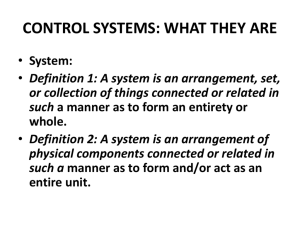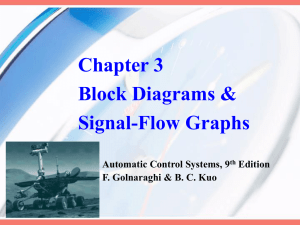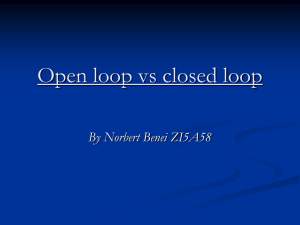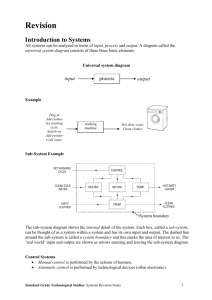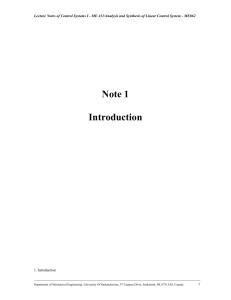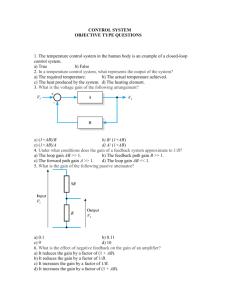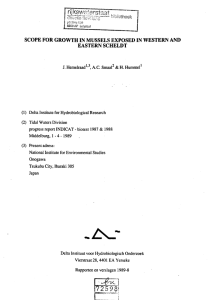Block Diagram Algebra
advertisement
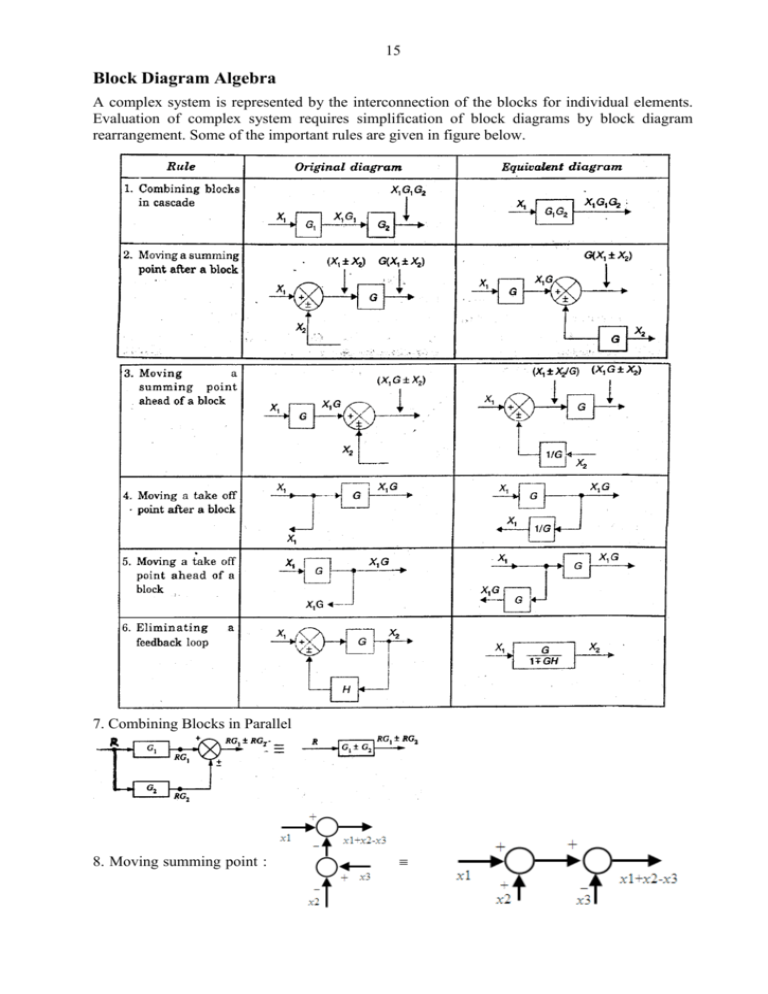
15
Block Diagram Algebra
A complex system is represented by the interconnection of the blocks for individual elements.
Evaluation of complex system requires simplification of block diagrams by block diagram
rearrangement. Some of the important rules are given in figure below.
7. Combining Blocks in Parallel
8. Moving summing point :
16
Example: Simplify the block diagram shown in Figure below.
17
Example: Obtain the transfer function C/R of the block diagram shown in Figure below.
[Ans]
Example: Derive the transfer function of the system shown below.
(a)
(b)
[Answer]
Example: Derive the transfer function of the system shown below.
18
Example: Find the transfer function of the following system.
{Answer}
Example: Find the output of the system shown below.
For Input R1:
……………………………………………. (1)
19
For input R2:
……………………………………………. (2)
{Answer}
Signal Flow Graph
SFG is a diagram that represents a set of simultaneous linear algebraic equations which describe
a system. Let us consider an equation, Y aX . It may be represented graphically as,
X
a
Y
where ‘a’ is called transmittance or transmission function.
Definitions in SFG
Node – A system variable, the value of which equals the sum of all incoming signals at the node.
Branch – A directed line segment joining two nodes.
Input/ Output node – node having only one outgoing/ incoming branch.
Path – A traversal of connected branches in the direction of branch arrows.
Forward path – A path from input to output node.
Loop – A closed path that originates and terminates on the same node.
Self-loop – A loop containing one branch.
Non-touching loops – Loops which do not have a common node.
Gain – Transmittance of a branch.
20
Construction of SFGs
The SFG of a system can be constructed from the describing equations:
x2 a12 x1 a32 x3
x3 a13 x1 a23 x2 a33 x3
x4 a24 x4 a34 x3
SFG from Block Diagram
Each variable in the block diagram becomes a node, and each block becomes a branch.
Mason’s Gain Formulae
It is possible to write the overall transfer function of a system through inspection of SFG using
Mason’s gain formulae given by, T ( Pi i ) / .
i
where T = overall gain of the system, Pi = path gain of ith forward path, determinant of SFG,
i value of for that part of the graph not touching the ith forward path.
1 Pj1 Pj 2 Pj 3
j
j
= 1 – [sum of loop gain of all individual loops] + [sum of all
j
gain-products of two non-touching loops] – [sum of all gain-products of three non-touching
loops] + ;
Pjk jth product of k non-touching loops .
21
Example
1. There are 6 forward paths with path gains
2. There are three individual loops with loop gains
3. There is only one combination of two non-touching loops
P12 H1H 2G4G5
4. There are no combinations of more than two non-touching loops.
5. Hence,
;
;
3 4 5 6 1
Thus, T
P11 P2 2 P3 3 P4 4 P5 5 P6 6
, where P1 , 1 , etc. are derived before.
Example
Draw the SFG and determine C/ R for the block diagram shown in Figure below.
{Answer}
22
Example
For the system represented by the following equations, find the transfer function X(s)/U(s) by
SFG technique.
x x1 3u
We need to Laplace transform the given sets of
x1 1 x1 x2 2u
equations in order to represent differentiated variables.
x2 2 x1 1u
X X 1 3U
X1
1
X2 2 u
s 1
s 1
X2
2
s
X1
1
s
u
X ( s) 1 2 s 3 [ s 2 1s 2 ]
U ( s)
s 2 1s 2
Example
Using Mason’s gain formulae find C/R of the SFG shown in Figure below.
{Answer}
23
Feedback Characteristics of Control Systems
Consider the block diagram of the open-loop and the closed-loop system shown below.
For open-loop system, C ( s) G ( s) R( s)
For closed-loop system, C (s) G(s) Ea (s) G(s)[ R(s) H (s)C (s)]
G( s)
1
Hence, we have, C ( s)
R( s) and, Ea ( s)
R( s )
1 G( s) H ( s)
1 G( s) H ( s)
It is seen from the above equations that in order to reduce error, the loop-gain G ( s ) H ( s ) should
be made large over the range of frequencies of interest, i.e., G(s) H (s) 1 .
1. Reduction of parameter variations by use of feedback
One of the important properties of negative feedback systems is the reduction in the sensitivity
to the variation in the parameters of the forward path. In the design of control systems, it is
important that the transfer function of the closed-loop system be relatively insensitive to small
changes in the values of the parameters of the components in the forward path of the system.
Let be a parameter of G(s). Then the sensitivity of G(s) with respect to the parameter is
defined as,
Fractional change in G( s) G / G G
.
SG
Fractional change in
/ G
C ( s)
G(s)
Now,
;
T ( s)
R( s ) 1 G ( s ) H ( s )
SG
T G G T
1 GH GH
ST
SG (1 GH )
1 G( s) H ( s)
T G T G
(1 GH )2
1
Thus feedback has reduced sensitivity in the variation in by the factor
.
1 GH
T H H T
H (1 GH ) G. G
GH
Again, ST
SH
SH
SH .
2
T H T H
(1 GH )
1 GH
G
It is seen that, the magnitude of two sensitivities are nearly equal for the variation of parameter
in the feedback path. Thus, feedback does not reduce the sensitivity to variation in the parameter
in feedback path.
Therefore, we can conclude that, G(s) in a closed-loop system may be less rigidly specified. On
the other hand, we must be careful in accuracy of H(s) in the feedback loop.
2. Control over system dynamics by use of feedback
Let us consider the simple feedback system shown below.
The open-loop transfer function is, G( s)
K
.
s
t
The impulse response for the non-feedback system would be, c(t ) Ke u (t ) Ke
K
The closed-loop transfer function of the above system is, T ( s)
.
sK
t /1
u (t ) .
24
( K )t
t /
u(t ) Ke 2 u(t ) .
The impulse response of the closed-loop system is, c(t ) Ke
The location of the pole and the dynamic response of the non-feedback and feedback system are
shown in Figure below.
It is seen that the time-constant of open-loop system is 1 1/ and that of closed-loop system
is 2 1/ ( K ) . As the time-constant of closed-loop system is less, its dynamic response is
faster than the same of the open-loop system.
3. Control of the effect of disturbance signal by use of feedback
A. Disturbance in the forward path
Cd ( s )
G2 ( s )
1
;
Td ( s ) 1 G1 ( s )G2 ( s ) H ( s ) G1 ( s ) H ( s )
or, Cd ( s)
Td ( s)
G1 ( s) H ( s)
If G1 ( s ) is made very large, the effect of disturbance on the output will be very small.
B. Disturbance in the feedback path
Cn ( s )
G1 ( s )G2 ( s ) H 2 ( s )
1
N ( s) 1 G1 ( s)G2 ( s) H1 ( s) H 2 ( s ) H1 ( s )
Therefore, the effect of noise on output is, Cn ( s )
1
N (s) .
H1 ( s )
Thus, for the optimum performance of the system, the measurement sensor should be designed
such that H1 (s) is maximum. This is equivalent to maximizing the SNR of the sensor.
4. Regenerative Feedback
The regenerative feedback is sometimes used for increasing the loop gain of the feedback
system. Figure in the following shows a feedback system where regenerative feedback occurs in
the inner loop.
25
The open-loop gain is, Go ( s)
G( s)
.
1 Ga ( s )
The system response is obtained as, C ( s)
R( s ) G ( s ) /1 Ga ( s )
R( s) G ( s)
1 Ga ( s)G ( s) /1 Ga ( s) 1 Ga ( s) G ( s) H ( s)
R( s )
. Due to high loop gain provided by the inner regenerative
H ( s)
feedback loop, the closed-loop transfer function becomes insensitive to G(s).
When, Ga (s) 1 , C ( s)
Example
A position control system is shown below. Assume, K=10, 2 , 1 . Evaluate: SKT , ST , ST .
For r (t ) 2 cos 0.5t and a 5% change in K , evaluate the steady-state response and the change in
steady-state response.
K
Here, G ( s)
, and H ( s)
s( s )
K dG
1
S KG
s(s )
1;
G dK
s(s )
dG
2
dH
SG
; S H
1
G d s s 2
H d
S KT
Therefore, ST
S
T
Now, T ( s)
S KG
s(s )
s 2 2s
2
1 G ( s ) H ( s ) s ( s ) K s 2 s 10
SG
s(s )
2s
2
1 G ( s ) H ( s ) s s( s ) K s 2 s 10
S H G ( s ) H ( s )
1 G ( s) H ( s)
K
10
2
s ( s ) K s 2 s 10
K
10
;
2
s s K s 2s 10
2
At s j 0.5 , T ( j 0.5) 1.02e j 0.102
Thus, css (t ) 2.04cos(0.5t 0.102)
Again, S KT
K T
T
K
s 2 2s
S KT
2
0.05
T K
T
K
s 2s 10
s 2 2s
10
0.5s(s 2)
; T ( j 0.5) 0.005e j 4.672
T (s) 2
0.05 2
2
2
s 2s 10
s 2s 10 (s 2s 10)
Thus, css (t ) T ( j 0.5) 2cos 0.5t 0.01cos(0.5t 4.672)
{Answer}
